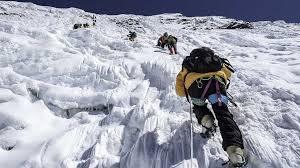Beautiful Lobuche Peak (6119 meters) is located in Nepal’s Khumbu area. The well-known mountain peak in Nepal, Lobuche Peak Climbing, is situated close to Khumbu Glacier and Lobuche Village. An impressive number of climbers plan to summit this beginner-friendly peak each year. So, a lot of people are curious about the ideal time to climb Lobuche Peak, just like you.
All of your questions about when is the greatest time to climb Lobuche Peak will be answered in this blog. Once you’ve read it all, you can schedule the peak at the right moment. In the end, you will plant a kiss on Lobuche’s snow-covered summit.
Situated in the renowned Khumbu or Everest Region, the peak is home to other fabled mountains across the globe. Among them are Lhotse, Ama Dablam, and Mount Everest. As you journey to Lobuche Peak, you will discover an area rich in natural and cultural treasures. You’ll get to enjoy an amazing adventure exploring the Everest Region.
It goes without saying that you want to schedule an excursion like Lobuche Peak during prime time. You are undoubtedly here to locate one. Thus, spring and autumn are the ideal seasons for climbing Lobuche Peak. While it is feasible to climb all year round, spring and autumn are the best times to do it.
Trekking routes in Nepal are crowded with travelers in the fall and spring. Everybody wants to go on trips when the timing is most favorable. The earlier seasons are more suited for trips such as Lobuche Peak than the Monsoon and Winter seasons.
We’ll cover all four seasons on this blog so you have plenty of inspiration. You’ll be able to choose wisely more rapidly if you have more knowledge about each season. It’s worth reading the additional headings we’ve written on climbing Lobuche Peak. So, shall we now get started?
You’ll Love Reading This: Dingboche to Lobuche | Lobuche to Gorakshep
High or Best Time for Lobuche Peak Climbing
The two greatest seasons for Lobuche Peak Climbing are autumn and spring, according to experts. The best seasons are marked by beautiful climbing conditions and consistent weather. Since the seasons are the busiest periods to climb Lobuche, you’ll likely run into other climbers there as well.
Autumn(September, October, and November)
One of the best seasons in Nepal for trekking and mountaineering is the fall. Due to its ideal, consistent weather and beautiful atmosphere, many individuals choose these months for travel excursions around Nepal. You will come across a lot of people on the Khumbu and other routes in the fall, whether you are trekking or climbing. Good news if you enjoy getting together with people.
September marks the start of the season, which follows the Monsoon season. Early September is somewhat likely to rain, albeit not very likely—mostly in the lower regions. From then on, autumn fully takes over. You can also anticipate an exceptionally clear view of the area, thanks to the efforts of the Monsoon.
Everything will gradually come together, and autumn will spread over Nepal. During the season, the mid- and lower-level temperatures typically range from 15 to 20 degrees. With the exception of morning and night, the weather is pleasant. Around Lobuche Peak, the temperature is between 0 and -11 degrees at the same moment. As would be expected in the highlands, it is constantly quite close to freezing.
Similarly, autumn is a terrific time to appreciate the mountains. During the season, everything in the area appears stunning. For viewers everywhere, the hills are still sunny. You will be met with a breathtaking view upon reaching Lobuche Peak that will temporarily hold your breath.
Autumn is the busiest season because of all these excellent reasons.
Spring for Lobuche Peak Climbing (March, April, and May)
Another ideal moment to visit Lobuche Peak Spring is climbing, flower-season time. Similar to autumn, there is an increase in traffic on Nepal’s mountain highways. Mountaineers and trekkers know that this is the best time of year to have experiences in Nepal, therefore they flock here. It is great for flowers and for consistently dry weather as well.
After Winter departs, spring arrives, bringing with it a lot of snow in the mountains. The photos of the snow-covered mountains are the first nice thing about spring. As Winter progresses, the temperature begins to return to average. In the spring, temperatures in the lower and middle regions of the Khumbu region range from 17 to 25 degrees. In comparison, Lobuche Peak experiences 10 to 15 degree temperatures.
In a similar vein, springtime has somewhat longer days than other seasons. This implies that you will have more time to hike the path or climb Lobuche. During this season, the sun is bright, providing excellent visibility. It is also still dry outside, which is wonderful. You always have unobstructed views of the mountains with clouds in the sky. It is easier to walk even on the dry pathways than on the wet ones.
For climbing Lobuche Peak, the finest months are often March, April, and May in the fall. To get to the summit, you will follow Lobuche through the rhododendron-filled woodlands. The weather in the fall will help you climb Lobuche Peak with little weather disruptions.
Off or Low Time for Lobuche Peak Climbing
As you are already aware, there are two low or off seasons for Lobuche Peak Climbing: winter and monsoon. Monsoon and Winter, in contrast to the preceding seasons, do not present ideal or simple climbing conditions. Rather, they make it difficult.
Thus, during these two times in Nepal, you will only discover a small number of adventure seekers scaling mountains.
Winter for Lobuche Peak climbing (December, January, and February)
Winter in Nepal begins in the fall and is the off-season when it is least recommended to climb Lobuche or any other summit. The highest regions get intense cold and heavy snowfall. It is difficult to attend the ascent under those circumstances. Thus, a few hard-core climbers organize Winter ascents. Winter, however, may be the right season for you if you enjoy having experiences. If not, then no.
December’s first few weeks might not be all that cold or snowy. But when January approaches, you discover that the higher areas are snow-covered. During those three months, the temperature at the summit of Lobuche Peak or very close to it might drop as low as -20 to -4 degrees. However, the lower Khumbu region stays warmer, ranging from -5 to 12 degrees, as usual.
There will be cold, snowy weather all season long. It will feel more like winter the higher you go.
Winter in Nepal’s highlands is an amazing season to be there, aside from the cold. It’s the season when the cliffs are covered in snow. The terrains, not only the mountains, are still covered in snow. If the weather holds up, now is an excellent time to visit Khumbu. The snow and extreme weather make the trek up Lobuche Peak more difficult. On the plus side, though, you will encounter amazing things.
Winter is also a serene season in the otherwise congested Khumbu Region. Extreme weather causes a large decrease in the number of persons who plan to visit. In the interim, if you stop by,
Monsoon(June, July, and August)
The monsoon is not the ideal season to climb Lobuche Peak. It’s a season of rain, ominous clouds, and sweltering temperatures, also known as summer. The season brings unpredictable and rainy weather to the entire nation. As such, during this time the trails leading up to the highlands, especially Lobuche, are mostly deserted.
Monsoon weather can be very unpredictable. It can be completely clear at times or gloomy and wet at other times. Temperatures in the lower Khumbu region, which is located below 4000 meters, range from 2 to 18 degrees. Similarly, this season’s temperatures in the higher regions range from -2 to 10 degrees. When it rains, the temperature lowers significantly.
Monsoon rainfall is typical. While upper areas have snowfall, lower regions receive more rainfall. The trails become slick and muddy during this time of year. There is also a continuous delay in the planes to Lukla, the expedition’s beginning site. Because of all these factors, the season is difficult.
Yes, the journey is difficult during the monsoon, but it’s also really picturesque. The vista is clear of all dust due to the monsoon’s downpour. As soon as the rain ceases, breathtaking sights are everywhere. Regretfully, it is the one best thing about the monsoon. Monsoon is not as lovely as Autumn or Spring in other ways.
The monsoon season is tranquil, just like winter. The area, which is often crowded, calms down in the monsoon. Lobuche Peak climbing can be peaceful when there are less tourists. However, you have to be prepared to face any hardship that the season presents.
Tips for Lobuche Peak Climbing
Prepare Physically and Mentally.
In the Himalayas, Lobuche Peak Climbing is a strenuous hike/climb. Long, steep, and rugged terrain require physical preparation. A fit body comes in handy for an adventure such as this one. Altitude sickness can also be fought off with enough physical training. Strength and cardio training are effective methods for developing muscle.
You will also require a strong mentality, in the same way. Your mind ought to be prepared to face any obstacles that the voyage may present. You must possess a never-say-die attitude. It is possible to ascend Lobuche Peak with such an attitude. Spend time developing a strong physique and mindset as a result.
Join Mountaineering Training
If this is your first ascent of Lobuche, you have not yet gained experience or expertise of mountaineering. If so, you ought to enrol in a climbing course to get the specifics. If not, climbing Lobuche Peak will just be challenging for you. During this climb, you will need to perform several mountaineering skills, including as utilizing crampons and walking with the assistance of ropes. Learn them all hence through climbing courses. You will receive all of the knowledge and skills from the coach.
Choose the best time for Lobuche Peak Climbing.
Winter, Monsoon, Autumn, or Spring. For the Lobuche expedition, timing is everything. We strongly advise you to do it in the spring and fall. As previously said, the best seasons for travel are autumn and spring. During such seasons, there is little variation in the weather. Winter and the Monsoon, however, are not entirely predictable. Sometimes the situation can get sour or worse. Only experts should partake in those seasons. Take a peek simply at Spring and Autumn if you are novel.
Choose the best agency.
Selecting the ideal moment is insufficient for a successful climb of Lobuche Peak. It would be ideal if you also received the advice of a reputable and knowledgeable agency. Verify the agency’s licensing status and climbing experience. We are a team with many years of expertise and a proven track record of accomplishment. Many people have climbed mountains in Nepal with the assistance of our highly skilled crew, including Lobuche and Mount Everest. You won’t be sorry you decided on us.
Frequently Asked Questions
How hard is Lobuche Peak Climbing?
Trekking peaks like Lobuche Peak Expedition are good for first-time climbers. It’s a tough climb even though it’s a trekking peak. You must walk or climb for six to ten hours on trekking days during the entire expedition. The hardest day is the summit day.
Climbing Lobuche Peak can be a little trickier than other trekking peaks in Nepal because of a little technical portion. You have to traverse high stone terraces and snow-covered slopes. Lobuche Peak is, in fact, a modest climb with a few minor technical difficulties. It requires planning beforehand and climbing instruction.
Where is Lobuche located?
At 6,119 meters, Lobuche, also known as Lobuche East, is situated between the Khumbu glacier and Lobuche Village. The settlement of Lobuche is honored in the mountain’s name. Lobuche East (6119m) and Lobuche West (6145m) are the two peaks of the peak. Because it is easier to get to, the Lobuche East is more well-liked. From the top of Lobuche, you have views of peaks such as Mt. Everest, Cho Oyu, Lhotse, Makalu, and others.
Can you see Mt Everest from Lobuche?
A captivating view of Mount Everest and other nearby peaks is available. This view lingers in the mind for a very long time. One nice place to see such a view is atop Lobuche Peak. From there, one can see Mt. Makalu, Cho Oyu, Lhotse, and even Kanchenjunga.
Mera Peak and Island peak, which one is better?
Two of Nepal’s best trekking peaks are Island Peak and Mera Peak. The peaks, which are part of the Everest Region, draw thousands of climbers each year. People frequently require clarification while deciding which mountain to climb. Well, there are lovely experiences to be had at both extremes. But compared to Island Peak, Lobuche Peak is a little more challenging. Aside from that, the two mountains are nearly identical. Therefore, Lobuche summit is a tough summit to climb. If not, you should consider Island Peak.
As a novice climber, can I climb Lobuche Peak?
Lobuche Peak is a trekking peak with a few minor complications, as was previously described. Anyone may reach Lobuche Peak with a little preparation, supervision, and basic climbing experience. Regardless of expertise level, everyone must get ready for the ascent. Lobuche Peak can be climbed by someone with adequate practice. Whether this is your first climb or not is irrelevant.


